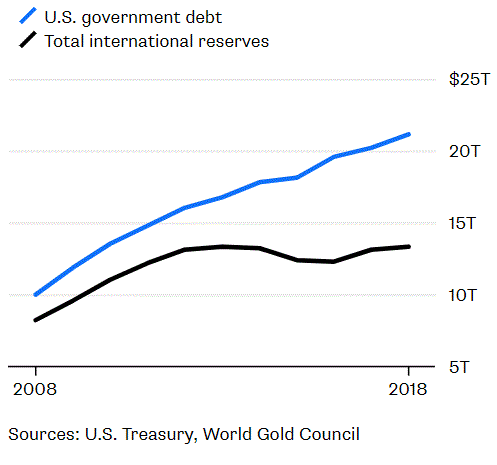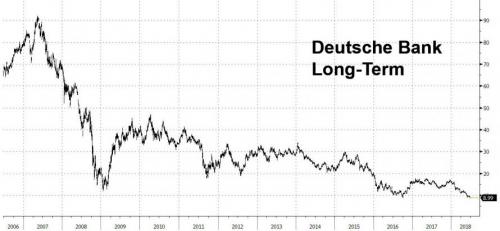Russia and Turkey’s moves out of U.S. debt and into the precious metal could be precursors of a bigger global shift.
by Leonid Bershidsky of Bloomberg
U.S. government debt and the world’s foreign exchange and gold reserves. Source: Bloomberg
Since December 2017, Russia has cut its holdings of U.S. foreign debt by more than half.
Instead, it’s been increasing the share of gold in its international reserves. That’s understandable behavior for a country that has to deal with an unpredictable U.S. sanctions policy, but it’s also part of a trend.
Foreign governments and international organizations account for a decreasing share of outstanding U.S. debt, and some economies have in recent years aggressively upped the share of gold in their reserves instead.
The Russian reduction of Treasury holdings, to $48.7 billion in April 2018 from $102.2 billion in December 2017, has been nothing short of dramatic, though it wasn’t a huge blow to the U.S. Russia’s holdings of American government bonds have long been dwarfed by those of China and Japan, as well as Brazil and some European countries. The U.S., with a debt of almost $21.2 trillion, can afford not to notice fluctuations in the tens of billions of dollars by an authoritarian state’s damage-control efforts and attempts to get away from the dollar.
U.S. Borrowing Faster Than the World Saves
The U.S. can lull itself into a certain sense of security as it watches the foreign-owned stock of its debt securities increase in absolute terms and as the dollar slips only slowly as a share of official foreign exchange reserves. The U.S. currency, according to the International Monetary Fund, made up 62.7 percent of these reserves in the fourth quarter of 2017, down from 64.59 percent in 2014 – but then the share of the next biggest reserve currency, the euro, has also dropped to 20.15 percent from 21.57 percent. This is hardly a tectonic shift.
And yet the U.S. does have a few things to worry about when it comes to its dominance of other countries’ official international reserves. In relative terms, governments and central banks are less and less interested in the ballooning U.S. debt.
Wary of U.S. Debt
U.S. debt, of course, is growing faster than global international reserves, and that partly explains the declining role of foreign countries in keeping the U.S. government solvent.
On the other hand, there’s plenty of U.S. debt to buy, but countries aren’t keen to increase its share in their reserves.
Instead, the share of U.S. Treasury securities has gone down to 25.4 percent currently from 28.1 percent in 2008, while the share of gold has held steady at about 11 percent over the same period, according to the World Gold Council.
That’s in part thanks to the efforts of a few eccentric gold bug authoritarians. Apart from Russia, they include Belarus, Kazakhstan and, recently, Turkey, where President Recep Tayyip Erdogan believes the West is out to punish Turkey for his sovereignty-enhancing policies.
Excerpt Above and Full Article From Bloomberg View – Access Here
Never miss an episode of The Goldnomics Podcast – Listen and subscribe on YouTube, ITunes, Soundcloud or Blubrry
News and Commentary
Gold Seen Fighting Back as Dollar Rebound Is Poised to Reverse (Bloomberg.com)
Gold edges higher, but lingers near 6-month trough (Reuters.com)
Asian Stocks Drop, Yen Gains on Trade Skepticism (Bloomberg.com)
Wall Street rally fizzles as tech stocks drag (Reuters.com)
U.S. Stocks Slide as Trade Angst Grows; Oil Climbs: Markets Wrap (Bloomberg.com)
Source: ZeroHedge
Why Russia and Turkey Diversifying Into Gold May Signal A Bigger Global Shift (Bloomberg.com)
Hedge Fund Managers See Echo of Past Crashes in Markets (Bloomberg.com)
China Think Tank Warns of Potential ‘Financial Panic’ in Leaked Note (Bloomberg.com)
Deutsche Bank Tumbles To New Record Low, Drags European Banks (ZeroHedge.com)
Listen on SoundCloud , Blubrry & iTunes. Watch on YouTube below
Gold Prices (LBMA AM)
27 Jun: USD 1,256.80, GBP 951.40 & EUR 1,079.97 per ounce
26 Jun: USD 1,257.15, GBP 949.15 & EUR 1,077.63 per ounce
25 Jun: USD 1,269.80, GBP 959.46 & EUR 1,090.25 per ounce
22 Jun: USD 1,269.70, GBP 954.05 & EUR 1,088.26 per ounce
21 Jun: USD 1,263.70, GBP 963.32 & EUR 1,096.51 per ounce
20 Jun: USD 1,273.25, GBP 967.29 & EUR 1,100.60 per ounce
19 Jun: USD 1,279.00, GBP 971.14 & EUR 1,108.89 per ounce
Silver Prices (LBMA)
27 Jun: USD 16.21, GBP 12.27 & EUR 13.93 per ounce
26 Jun: USD 16.23, GBP 12.25 & EUR 13.90 per ounce
25 Jun: USD 16.38, GBP 12.35 & EUR 14.05 per ounce
22 Jun: USD 16.43, GBP 12.35 & EUR 14.11 per ounce
21 Jun: USD 16.25, GBP 12.33 & EUR 14.07 per ounce
20 Jun: USD 16.29, GBP 12.38 & EUR 14.09 per ounce
19 Jun: USD 16.36, GBP 12.42 & EUR 14.16 per ounce
Recent Market Updates
– London House Prices Fall 1.9% In Quarter – Bubble Bursting?
– Gold Exports To London From U.S. Surge 152% In 2018
– Manipulation of Gold & Silver by Bullion Banks Is “Undeniable”
– “Perfect Environment For Gold” As Fed Will Weaken Dollar and Create Inflation – Rickards
– Russia Buys 600,000 oz Of Gold In May After Dumping Half Of US Treasuries In April
– In Gold, Silver and Bitcoin We Trust? Goldnomics Podcast with Ronald-Peter Stoeferle
– Own A “Bit Of Gold” As We Are Moving Ever Closer To A Trade War
– Bitcoin Price To $0 Or $1 Million In One Year? MoneyConf 2018 Poll
– Cashless Society – Good or Bad? MoneyConf 2018 Video
– Do We Still Need Banks In The Age Of Fintech?
– Total US Government Debt Is $200 Trillion – Debt Clock Ticking To Next Crisis
– All Gold is Not Equal – Goldnomics Podcast (Episode 4)
– “Without Gold I Would Have Starved To Death” – ECB Governor
– Swiss Government Pension Fund To Buy Gold Bars Worth Some €600 Million
The post Why Russia and Turkey Diversifying Into Gold May Signal A Bigger Global Shift appeared first on GoldCore Gold Bullion Dealer.
![]()




